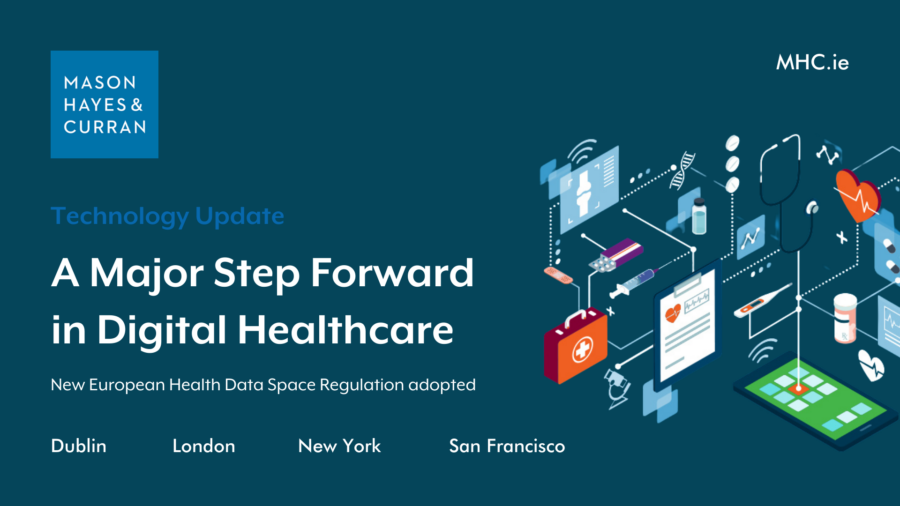A Major Step Forward in Digital Healthcare
New European Health Data Space Regulation adopted

The EU Council has adopted the European Health Data Space Regulation, marking a major advance in digital healthcare. Our Data & Technology, and Digital Health teams examine how this framework, approved in January 2025, establishes new standards for accessing and sharing health data across the EU, benefiting patients, healthcare providers, researchers and industry.
The European Union has taken a significant step forward in digital healthcare with the adoption of the European Health Data Space Regulation (EHDS) on 21 January 2025. EHDS is expected to come into force in March 2025 and will gradually roll out over the coming years. This landmark legislation aims to transform how health data is accessed, shared, and utilised across the EU, promising benefits for patients, healthcare professionals, researchers, and industry stakeholders.
Patient rights and control
Under the EHDS, EU citizens gain unprecedented control over their health data. Patients will have immediate access free of charge to their electronic health records. They will also be able to share this information with healthcare providers across national borders. EHDS enables patients to add information to their records, correct errors, and maintain oversight of who accesses their health data, while ensuring their privacy through robust security measures.
For healthcare delivery, ie “primary use”, patients will be able to restrict access to use of their health data. Member States will also have the option to provide for a full opt-out, enabling people who do not want to take part in the exchanges under the EHDS to revert to the previous method of exchanging medical records.
Patients will also have a right to opt-out specifically from their health records being used for health research, policy-making and re-use, ie “secondary use”, in an easy and reversible way. However, for certain important public interests and under strict safeguards, including transparency requirements, the opt out will not apply.
Healthcare professional benefits
For healthcare professionals, the EHDS aims to streamline access to patient records across different systems and borders. This improved interoperability aims to enhance care quality by providing comprehensive patient histories and eliminating redundant tests and procedures. This aims to allow faster access to critical health information, particularly valuable in emergency situations or when treating patients from other EU Member States.
Secondary use framework
The EHDS creates a structured environment for health data research while maintaining strict privacy protections. Researchers, industry and public institutions will be able to access larger pools of high-quality health data. In addition to enhanced access, they will be able to know what data is available, where, and of what quality. However, restrictions will apply to the use of this data:
- Data must be processed in secure environments
- Only anonymised or pseudonymised data can be accessed
- Use is restricted to specific purposes benefiting society
- Individual privacy protections remain paramount
Technical requirements and data storage
The EHDS mandates specific requirements for electronic health record systems. Healthcare providers and manufacturers must implement harmonised software components for interoperability, logging and security. This requirement extends across the healthcare technology spectrum, from hospital record systems to imaging devices such as ultrasound and MRI scanners.
Implementation and governance
The EHDS is expected to come into force in March 2025 and will roll out in phases. Between 2025 and 2027, the focus will be on developing technical specifications through secondary legislation. From 2027 to 2029, Member States will establish data hubs and connect to EU-wide infrastructure. Full implementation is targeted for 2029, supported by joint pilot projects between the European Commission and Member States, however provisions relating to clinical trials and human genetic data are set to apply from 2031.
Oversight will be maintained through a new European Health Data Space Board, with digital health authorities in each Member State and dedicated bodies managing data access requests.
Conclusion
For the life sciences and healthcare industry, the EHDS presents both opportunities and obligations. The EHDS represents a fundamental shift in how health data is managed and utilised across the EU. Organisations will benefit from standardised access to health data for research and development purposes, while also facing new requirements for data sharing, interoperability and security. The EHDS is expected to foster innovation in medical devices, digital health applications, and pharmaceutical development.
While the implementation timeline extends several years into the future, organisations are advised to begin preparing to capitalise on the opportunities presented by EHDS now while also preparing for compliance with these new requirements well in advance of the applicable dates.
For more information and expert advice on the potential impact of the EHDS on your organisation’s operations, contact a member of our Data & Technology or Digital Health teams.
People also ask
What health information can patients access under EHDS? |
Patients can access priority categories of data including patient summaries, electronic prescriptions, medical imaging studies and reports, test results, and discharge reports. |
Where will health data be stored? |
Health data must generally be stored within the EU, with exceptions for countries with EU GDPR adequacy decisions, such as the US (for certified recipients), UK, Switzerland, Japan and Canada. |
When does EHDS take effect? |
The EHDS will enter into force in early 2025, with general application beginning in 2027. Secondary use provisions apply from 2029, and clinical trial and genetic data provisions take effect in 2031. |
The content of this article is provided for information purposes only and does not constitute legal or other advice.
Share this:






